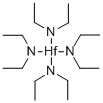TETRAKIS(DIETHYLAMINO)HAFNIUM CAS#: 19824-55-6; ChemWhat Code: 33546
Identification
Physical Data
| Appearance | Yellow liquid |
Spectra
No data available
Route of Synthesis (ROS)
| Conditions | Yield |
| In toluene at -79 – 20℃; for 4h; Inert atmosphere; Schlenk technique; Glovebox; | 76% |
Safety and Hazards
| Pictogram(s) | |
| Signal | Danger |
| GHS Hazard Statements | H225 (100%): Highly Flammable liquid and vapor [Danger Flammable liquids] H260 (33.85%): In contact with water releases flammable gases which may ignite spontaneously [Danger Substances and mixtures which in contact with water, emit flammable gases] H261 (92.31%): In contact with water releases flammable gas [Danger Substances and mixtures which in contact with water, emit flammable gases] H300 (33.85%): Fatal if swallowed [Danger Acute toxicity, oral] H310 (33.85%): Fatal in contact with skin [Danger Acute toxicity, dermal] H314 (40%): Causes severe skin burns and eye damage [Danger Skin corrosion/irritation] H315 (60%): Causes skin irritation [Warning Skin corrosion/irritation] H319 (60%): Causes serious eye irritation [Warning Serious eye damage/eye irritation] H330 (33.85%): Fatal if inhaled [Danger Acute toxicity, inhalation] H335 (100%): May cause respiratory irritation [Warning Specific target organ toxicity, single exposure; Respiratory tract irritation] |
| Precautionary Statement Codes | P210, P223, P231+P232, P233, P240, P241, P242, P243, P260, P261, P262, P264, P264+P265, P270, P271, P280, P284, P301+P316, P301+P330+P331, P302+P335+P334, P302+P352, P302+P361+P354, P303+P361+P353, P304+P340, P305+P351+P338, P305+P354+P338, P316, P319, P320, P321, P330, P332+P317, P337+P317, P361+P364, P362+P364, P363, P370+P378, P402+P404, P403+P233, P403+P235, P405, and P501 (The corresponding statement to each P-code can be found at the GHS Classification page.) |
Other Data
No data available
| Druglikeness | |
| Lipinski rules component | |
| Molecular Weight | 471.042 |
| HBA | 4 |
| HBD | 0 |
| Matching Lipinski Rules | 3 |
| Veber rules component | |
| Polar Surface Area (PSA) | 12.96 |
| Rotatable Bond (RotB) | 12 |
| Matching Veber Rules | 1 |
| Use Pattern |
| TETRAKIS(DIETHYLAMINO)HAFNIUM CAS 19824-55-6 are frequently used in thin film deposition, particularly in the semiconductor manufacturing industry. They serve as precursor materials for thin film preparation, for example, in the fabrication processes of integrated circuits and other electronic devices. |
Buy Reagent | |
| No reagent supplier? | Send quick inquiry to ChemWhat |
| Want to be listed here as a reagent supplier? (Paid service) | Click here to contact ChemWhat |
Approved Manufacturers | |
| Want to be listed as an approved manufacturer (Requires approvement)? | Please download and fill out this form and send back to approved-manufacturers@chemwhat.com |
Other Suppliers | |
| Watson International Limited | Visit Watson Official Website |
Contact Us for Other Help | |
| Contact us for other information or services | Click here to contact ChemWhat |



